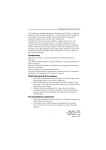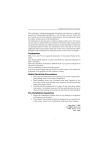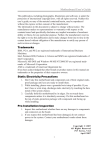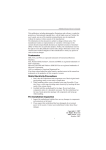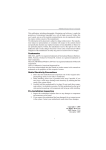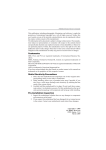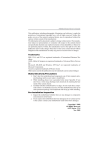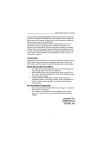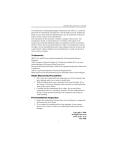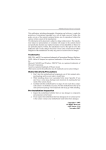Download PC CHIPS P33G (V1.0)
Transcript
Motherboard User’s Guide This publication, including photographs, illustrations and software, is under the protection of international copyright laws, with all rights reserved. Neither this user’s guide, nor any of the material contained herein, may be reproduced without the express written consent of the manufacturer. The information in this document is subject to change without notice. The manufacturer makes no representations or warranties with respect to the contents hereof and specifically disclaims any implied warranties of merchantability or fitness for any particular purpose. Further, the manufacturer reserves the right to revise this publication and to make changes from time to time in the content hereof without obligation of the manufacturer to notify any person of such revision or changes. Trademarks IBM, VGA, and PS/2 are registered trademarks of International Business Machines. Intel, Pentium/II/III, Pentium 4, Celeron and MMX are registered trademarks of Intel Corporation. Microsoft, MS-DOS and Windows 98/ME/NT/2000/XP are registered trademarks of Microsoft Corporation. AMI is a trademark of American Megatrends Inc. It has been acknowledged that other brands or product names in this manual are trademarks or the properties of their respective owners. Static Electricity Precautions 1. Don’t take this motherboard and components out of their original staticproof package until you are ready to install them. 2. While installing, please wear a grounded wrist strap if possible. If you don’t have a wrist strap, discharge static electricity by touching the bare metal of the system chassis. 3. Carefully hold this motherboard by its edges. Do not touch those components unless it is absolutely necessary. Put this motherboard on the top of static-protection package with component side facing up while installing. Pre-Installation Inspection 1. Inspect this motherboard whether there are any damages to components and connectors on the board. 2. If you suspect this motherboard has been damaged, do not connect power to the system. Contact your motherboard vendor about those damages. Copyright © 2006 All Rights Reserved P33G Series, V1.0 March 2007 i Motherboard User’s Guide Table of Contents Trademark ............................................................................................................ i Static Electricity Precautions ......................................................................................... i Pre-Installation Inspection ............................................................................................. i Chapter 1: Introduction ..................................................................................... 1 Key Features .................................................................................................................... 1 Package Contents ........................................................................................................... 4 Chapter 2: Motherboard Installation .............................................................. 5 Motherboard Components ............................................................................................ 6 I/O Ports .......................................................................................................................... 7 Installing the Processor ................................................................................................. 8 Installing Memory Modules .......................................................................................... 9 Jumper Settings ............................................................................................................ 1 0 Install the Motherboard ............................................................................................... 11 Connecting Optional Devices ..................................................................................... 1 2 Install Other Devices .................................................................................................... 1 4 Expansion Slots ............................................................................................................ 1 7 Chapter 3: BIOS Setup Utility ....................................................................... 19 Introduction .................................................................................................................. 1 9 Running the Setup Utility ................................................... …………………………...19 Standard CMOS Setup Page ....................................................................................... 2 0 Advanced Setup Page .................................................................................................. 2 1 Advanced Chipset Setup Page .................................................................................... 2 3 Integrated Peripherals Page ....................................................................................... 2 4 Power Management Setup Page ................................................................................ 2 5 PCI/PnP Setup Page .................................................................................................... 2 7 PCI Health Status Page ............................................................................................... 2 7 Frequency/Voltage Control Page ............................................................................... 2 9 Load Default Settings ................................................................................................... 3 0 Supervisor Password Page .......................................................................................... 3 0 User Password Page .................................................................................................... 3 1 Save & Exit Setup ......................................................................................................... 3 1 Exit Without Saving ...................................................................................................... 3 1 Chapter 4: Software & Applications .............................................................. 32 Introduction .................................................................................................................. 3 2 Installing Support Software ........................................................................................ 3 2 Bundled Software Installation .................................................................................... 3 4 ii Motherboard User’s Guide Notice: 1 Owing to Microsoft’s certifying schedule is various to every supplier, we might have some drivers not certified yet by Microsoft. Therefore, it might happen under Windows XP that a dialogue box (shown as below) pop out warning you this software has not passed Windows Logo testing to verify its compatibility with Windows XP. Please rest assured that our RD department has already tested and verified these drivers. Just click the “Continue Anyway” button and go ahead the installation. iii Chapter 1: Introduction Chapter 1 Introduction This motherboard has a LGA775 socket for latest Intel® CoreTM2 Duo/ Celeron® D processors with Hyper-Threading Technology and Front-Side Bus (FSB) speeds up to 1066 MHz. Hyper-Threading Technology, designed to take advantage of the multitasking features, giving you the power to do more things at once. It integrates the SiS671FX Northbridge and SiS968 Southbridge that supports theSerial ATA interface for high-performance and mainstream desktop PCs; the built-in USB 2.0 providing higher bandwidth, implementing Universal Serial Bus Specification Revision 2.0 and is compliant with OHCI 1.1 and EHCI 2.0. It supports High Definition Audio Codec and provides Ultra DMA 133/ 100/66/33 function. It has one PCI Expressx16, one PCI Expressx1, one CNR (optional) and two 32-bit PCI slots. There is a full set of I/O ports including two PS/2 ports for mouse and keyboard, οne serial port, one parallel port (optional), one VGA port, one LAN port (optional), four back-panel USB 2.0 ports and Audio jacks for microphone, line-in and 6/8-channel (optional) line-out and onboard USB headers providing extra ports by connecting the Extended USB Module to the motherboard. It is a Micro ATX motherboard and has power connectors for an ATX power supply. Key Features The key features of this motherboard include: LGA775 Socket Processor • • Supports the latest Intel® CoreTM2 Duo/Celeron® D processors with Hyper-Threading Technology Supports up to 1066 MHz Front-Side Bus Note: Hyper-Threading technology enables the operating system into thinking it’s hooked up to two processors, allowing two threads to be run in parallel, both on separate ‘logical’ processors within the same physical processor. Chipset There are SiS671FX Northbridge and SiS968 in the chipsets in accordance with an innovative and scalable architecture with proven reliability and performance. • High Performance Host Interface: Supports Intel® CoreTM2 Duo/ Celeron® D processor family with FSB 1066 MHz • Hyper-Threading Technology 1 Motherboard User’s Guide • • • • • • System Memory Controller Support: DDR2 SDRAM with up to maximum memory of 4 GB. PCI Express Graphics Interface Support: One PCI Express x16 port PCI Bus Interface Support: PCI Revision 2.3 Specification at 33MHz Integrade Serial ATA Host Controller: Independent DMA operation on two ports with Data transfer rates up to 3.0 Gb/s Intgrated IDE Controller: Ultra DMA-133/100/66/33 Bus Master EIDE Controller USB 2.0: Integrated USB 2.0 interface, supporting up to eight functional ports Memory Support • Two 240-pin DIMM sockets for DDR2 SDRAM memory modules • Supports DDR2 667/533/400 memory bus • Maximum installed memory is 4 GB Expansion Slots • Two 32-bit PCI slots • One PCI Expressx16 slot • One PCI Expressx1 slot • One CNR slot (optional) Onboard IDE channels • One IDE Connector • Supports PIO (Programmable Input/Output) and DMA (Direct Memory Access) modes • Supports IDE Ultra DMA bus mastering with transfer rates of 133/100/ 66/33 MB/sec Serial ATA • Two Serial ATA Connectors • Transfer rate exceeding best ATA (3.0 Gb/s) with scalability to higher rates • Low pin count for both host and devices Audio (Optional) • • • • • 7.1+ 2 Channel High Definition Audio Codec All DACs support 192k/96k/48k/44.1kHz sample rate High-quality analog differential CD input Meets Microsoft WHQL/WLP 3.0 audio requirements Direct Sound 3DTM compatible • • • • 5.1Channel High Definition Audio Codec ADCs support 44.1k/48k/96k sample rate Meet Microsoft WHQL/WLP 3.0x audio requirements Direct Sound 3DTM compatible 2 Chapter 1: Introduction LAN (Optional) • • • 10BASE-T/100BASE-TX IEEE 802.3u fast Ethernet transceiver Low-power mode MII and 7-wire serial interface • • • • Integrated 10/100/1000BASE-T transceiver 10/100/1000BASE-T full-duplex/half-duplex MAC Wake on LAN (WOL) support meeting the ACPI requirements Statistics for SNMP MIB II, Ethernet-like MIB, and Ethernet MIB Onboard I/O Ports • Two PS/2 ports for mouse and keyboard • One serial port • One parallel port (optional) • One VGA port • One LAN port (optional) • Four back-panel USB2.0 ports • Audio jacks for microphone, line-in and 6/8-channel (optional) line-out BIOS Firmware This motherboard uses AMI BIOS that enables users to configure many system features including the following: • Power management • Wake-up alarms • CPU parameters and memory timing • CPU and memory timing The firmware can also be used to set parameters for different processor clock speeds. Dimensions • Micro ATX form factor of 244 x 210 mm Note: Hardware specifications and software items are subject to change without notification. 3 Motherboard User’s Guide Package Contents Your motherboard package ships with the following items: The motherboard The User’s Guide One diskette drive ribbon cable (optional) One IDE drive ribbon cable The Software support CD Optional Accessories You can purchase the following optional accessories for this motherboard. The Extended USB module The CNR v.90 56K Fax/Modem card The Serial ATA cable The Serial ATA power cable Note: You can purchase your own optional accessories from the third party, but please contact your local vendor on any issues of the specification and compatibility. 4 Chapter 2: Motherboard Installation Chapter 2 Motherboard Installation To install this motherboard in a system, please follow these instructions in this chapter: Identify the motherboard components Install a CPU Install one or more system memory modules Make sure all jumpers and switches are set correctly Install this motherboard in a system chassis (case) Connect any extension brackets or cables to headers/connectors on the motherboard Install peripheral devices and make the appropriate connections to headers/connectors on the motherboard Note: 1. 2. Before installing this motherboard, make sure jumper CLR_CMOS1 is under Normal setting. See this chapter for information about locating CLR_CMOS1 and the setting options. Never connect power to the system during installation; otherwise, it may damage the motherboard. 5 Motherboard User’s Guide Motherboard Components LABEL COMPONENTS ® ® LGA775 socket for Intel CoreTM 2 Duo/Celeron D CPUs 240-pin DDR2 SDRAM slots 2. DDRII1~2 CPU cooling fan connector 3. CPU_FAN1 Onboard infrared header 4. IR1 Floppy disk drive connector 5. FDD1 Standard 24-pin ATX power connector 6. PWR1 Primary IDE channel 7. IDE1 SPI ROM Header 8. SPI_ROM System cooling fan connector 9. SYS_FAN1 Serial ATA connectors 10. SATA1~2 Front panel switch/LED header 11. PANEL1 Speaker header 12. SPK1 Front Panel USB headers 13. F_USB1~2 14. CLR_CMOS1 Clear CMOS jumper SPDIF out header 15. SPDIFO1 CNR slot 16. CNR1* 32-bit add-on card slots 17. PCI1~2 Analog audio input connector 18. CD_IN1 Front panel audio header 19. F_AUDIO1 PCI Express x1 slot 20. PCI-E2 PCI Express x16 slot for graphics interface 21. PCI-E1 Auxiliary 4-pin power connector 22. PWR2 1. CPU Socket * Stands for optional components 6 Chapter 2: Motherboard Installation I/O Ports (Optional) The illustration below shows a side view of the built-in I/O ports on the motherboard. PS/2 Mouse Use the upper PS/2 port to connect a PS/2 pointing device. PS/2 Keyboard Use the low er PS/2 port to connect a PS/2 keyboard. Parallel Port (LPT1) (optional) Use the Parallel port to connect printers or other parallel communications devices. COM1 Use the COM port to connect serial devices such as mice or fax/modems. COM1 is identified by the system as COM1. VGA Use the VGA port to connect VGA devices. LAN Port (optional) Connect an RJ-45 jack to the LAN port to connect your computer to the Netw ork. USB Ports Use the USB ports to connect USB devices. Audio Ports Use these three audio jacks to connect audio devices. The first jack is for stereo Line-In signal, the second jack for stereo Line-Out signal, and the third jack for Microphone. Use these audio jacks to connect audio devices. The Aport is for stereo Line-In signal, w hlie the C port is for microphone in signal. The motherboard supports 8-channel audio devices that correspond to A, B, D and E port respectively. In addition, all of the three ports, A, B and D provide users w ith both right & left channels individually. 7 Motherboard User’s Guide Installing the Processor This motherboard has a LGA775 socket for the latest Intel® CoreTM2 Duo/ Celeron® D processors. When choosing a processor, consider the performance requirements of the system. Performance is based on the processor design, the clock speed and system bus frequency of the processor, and the quantity of internal cache memory and external cache memory. CPU Installation Procedure Follow these instructions to install the CPU: A. Read and follow the instructions shown on the sticker on the CPU cap. B. Unload the cap • Use thumb & forefinger to hold the lifting tab of the cap. • Lift the cap up and remove the cap completely from the socket. C. Open the load plate • Use thumb & forefinger to hold the hook of the lever, pushing down and pulling aside unlock it. • Lift up the lever. • Use thumb to open the load plate. Be careful not to touch the contacts. D. Install the CPU on the socket • Orientate CPU package to the socket. Make sure you match triangle marker to pin 1 location. 8 Chapter 2: Motherboard Installation E. Close the load plate • Slightly push down the load plate onto the tongue side, and hook the lever. • CPU is locked completely. F. Apply thermal grease on top of the CPU. G. Fasten the cooling fan supporting base onto the CPU socket on the motherboard. H. Make sure the CPU fan is plugged to the CPU fan connector. Please refer to the CPU cooling fan user’s manual for mor detail installation procedure. Note 1: To achieve better airflow rates and heat dissipation, we suggest that you use a high quality fan with 3800 rpm at least. CPU fan and heatsink installation procedures may vary with the type of CPU fan/ heatsink supplied. The form and size of fan/heatsink may also vary. Note 2: The fan connector supports the CPU cooling fan of 1.1A~2.2A (26.4W max.) at +12V. Note 3: Do Not remove the CPU cap from the socket before installing a CPU. Note 4: Return Material Authorization (RMA) requests will be accepted only if the motherboard comes with the cap on the LGA775 socket. Installing Memory Modules This motherboard accommodates two 240-pin DIMM sockets (Dual Inline Memory Module) for unbuffered DDR2 667/533/400 memory modules (Double Data Rate SDRAM), and maximum 4 GB installed memory. Over its predecessor, DDR-SDRAM, DDR2-SDRAM offers greater bandwith and density in a smaller packahe along with a reduction in power consumption. In addition, DDR2-SDRAM offers new features and functions that enable a higher clock rate and data rate operations of 400 MHz, 533 MHz and 667 MHz. DDR2 transfer 64 bits of data twice every clock cycle. 9 Motherboard User’s Guide Memory Module Installation Procedure These modules can be installed with up to 4 GB system memory. Refer to the following to install the memory module. 1. Push down the latches on both sides of the DIMM socket. 2. Align the memory module with the socket. There is a notch on the DIMM socket that you can install the DIMM module in the correct direction. Match the cutout on the DIMM module with the notch on the DIMM socket. 3. Install the DIMM module into the socket and press it firmly down until it is seated correctly. The socket latches are levered upwards and latch on to the edges of the DIMM. 4. Install any remaining DIMM modules. Jumper Settings Connecting two pins with a jumper cap is SHORT; removing a jumper cap from these pins, OPEN. 10 Chapter 2: Motherboard Installation CLR_CMOS1: Clear CMOS Jumper Use this jumper to clear the contents of the CMOS memory. You may need to clear the CMOS memory if the settings in the Setup Utility are incorrect and prevent your motherboard from operating. To clear the CMOS memory, disconnect all the power cables from the motherboard and then move the jumper cap into the CLEAR setting for a few seconds. 1 CLR_CMOS1 Function Jum per Normal Short Pins 2-3 Clear CMOS Short Pins 1-2 Note: To avoid the system unstability after clearing CMOS, we recommend users to enter the main BIOS setting page to “Load Optimal De-faults” and then “Save Changes and Exit”. Install the Motherboard Install the motherboard in a system chassis (case). The board is a Micro ATX size motherboard. You can install this motherboard in an ATX case. Make sure your case has an I/O cover plate matching the ports on this motherboard. Install the motherboard in a case. Follow the case manufacturer’s instructions to use the hardware and internal mounting points on the chassis. 11 Motherboard User’s Guide Connect the power connector from the power supply to the PWR1 connector on the motherboard. The PWR2 is a +12V connector for CPU Vcore power. If there is a cooling fan installed in the system chassis, connect the cable from the cooling fan to the SYS_FAN1 fan power connector on the motherboard. Connect the case switches and indicator LEDs to the PANEL1 header. Here is a list of the PANEL1 pin assignments. Pin 1 3 5 7 9 Signal HD_LED_P(+) HD_LED_N(-) RESET_SW_N(-) RESET_SW_P(+) RSVD_DNU Pin 2 4 6 8 10 Signal FP PWR/SLP(+) FP PWR/SLP(-) POWER_SW_P(+) POWER_SW_N(-) KEY Connecting Optional Devices Refer to the following for information on connecting the motherboard’s optional devices: SPK1: Speaker Header Connect the cable from the PC speaker to the SPK1 header on the motherboard. Pin 1 3 Signal VCC NC Pin 2 4 12 Signal Key Signal Chapter 2: Motherboard Installation F_AUDIO1: Front Panel Audio Header This header allows the user to install auxiliary front-oriented microphone and line-out ports for easier access. Pin 1 3 5 7 9 Signal PORT1L PORT1R PORT2R SENSE_SEND PORT2L Pin 2 4 6 8 10 Signal GND PRESENCE# Sense1_return KEY Sense2_return F_USB1/F_USB 2: Front panel USB Headers The motherboard has USB ports installed on the rear edge I/O port array. Additionally, some computer cases have USB ports at the front of the case. If you have this kind of case, use auxiliary USB headers F_USB1/F_USB2 to connect the front-mounted ports to the motherboard. Pin 1 3 5 7 9 1. 2. 3. Sig n al V ERG_FP_USBPW R0 USB_ FP_P0 (-) USB_ FP_P0 (+) GROUND KEY Pin 2 4 6 8 10 Sig n al V ERG_FP_USBPW R0 USB_ FP_P1 (-) USB_ FP_P1 (+) GROUND NC Locate the F_USB1/F_USB2 header on the motherboard. Plug the bracket cable onto the F_USB1/F_USB2 header. Remove a slot cover from one of the expansion slots on the system chassis. Install an extension bracket in the opening. Secure the extension bracket to the chassis with a screw. IR1: Infrared Header The infrared port allows the wireless exchange of information between your computer and similarly equipped devices such as printers, laptops, Personal Digital Assistants (PDAs), and other computers. Pin 1 3 5 1. 2. Signal Pin NC 2 +5V 4 IRTX 6 Signal KEY GND IRRX Locate the infrared port-IR1 header on the motherboard. If you are adding an infrared port, connect the ribbon cable from the port to the IR1 header and then secure the port to an appropriate place in your system chassis. 13 Motherboard User’s Guide SPDIFO1: S/PIF Out Header S/PDIF (Sony/Plilips Digital Interface) is a standard audio transfer file format and allows the transfer of digatal audio signals from one device to another without having to be converted first to an analog format. Via a specific audio cable, you can connect the SPDIFO1 header+(S/PDIF output) on the motherboard to the S/PDIF digital input on the external speakers or AC Decode devices. Pin 1 3 Signal SPDIFOUT KEY Pin 2 4 Signal 5VA GDN SPI_ROM: SPI ROM Header This 4 Mb ROM contains the programmable BIOS program. Pin 1 3 5 7 Signal CHIPSELECT DATAOUTPUT WRITEPROTECT CND Pin 2 4 6 8 Signal VCC HOLD CLOCK DATAINPUT Install Other Devices Install and connect any other devices in the system following the steps below. 14 Chapter 2: Motherboard Installation Floppy Disk Drive The motherboard ships with a floppy disk drive cable that can support one or two drives. Drives can be 3.5" or 5.25" wide, with capacities of 360 K, 720 K, 1.2 MB, 1.44 MB, or 2.88 MB. Install your drives and connect power from the system power supply. Use the cable provided to connect the drives to the floppy disk drive connector FDD1. IDE Devices IDE devices include hard disk drives, high-density diskette drives, and CD-ROM or DVD-ROM drives, among others. The motherboard ships with an IDE cable that can support one or two IDE devices. If you connect two devices to a single cable, you must configure one of the drives as Master and one of the drives as Slave. The documentation of the IDE device will tell you how to configure the device as a Master or Slave device. The Master device connects to the end of the cable. Install the device(s) and connect power from the system power supply. Use the cable provided to connect the device(s) to the Primary IDE channel connector IDE1 on the motherboard. Serial ATA Devices The Serial ATA (Advanced Technology Attachment) is the standard interface for the IDE hard drives, which is designed to overcome the design limitations while enabling the storage interface to scale with the growing media rate demands of PC platforms. It provides you a faster transfer rate of 3.0 Gb/s. If you have installed a Serial ATA hard drive, you can connect the Serial ATA cables to the Serial ATA hard drive or the connector on the motherboard. On the motherboard, locate the Serial ATA connectors SATA1/2, which support new Serial ATA devices for the highest data transfer rates, simpler disk drive cabling and easier PC assembly. It eliminates limitations of the current Parallel ATA interface, but maintains register compatibility and software compatibility with Parallel ATA. 15 Motherboard User’s Guide Analog Audio Input Header If you have installed a CD-ROM drive or DVD-ROM drive, you can connect the drive audio cable to the onboard sound system. When you first start up your system, the BIOS should automatically detect your CD-ROM/DVD drive. If it doesn’t, enter the Setup Utility and configure the CD-ROM/DVD drive that you have installed. On the motherboard, locate the 4-pin header CD_IN1. Pin 1 2 3 Signal CD IN L GND GND 4 CD IN R 16 Chapter 2: Motherboard Installation Expansion Slots This motherboard has one PCI Ex16, one PCI Ex1, one CNR (optional) and two 32-bit PCI slots. 17 Motherboard User’s Guide Follow the steps below to install an PCI Express/CNR/PCI expansion card. 1 Locate the PCI Express, CNR or PCI slots on the motherboard. 2 Remove the blanking plate of the slot from the system chassis. 3 Install the edge connector of the expansion card into the slot. Ensure the edge connector is correctly seated in the slot. 4 Secure the metal bracket of the card to the system chassis with a screw. PCI Express Slot You can install an external PCI Express graphics card that is fully compliant to the PCI Express Base Specification revsion 1.0a. CNR Slot (optional) You can install the CNR (Communications and Networking Riser) cards in this slot, including LAN, Modem, and Audio functions. PCI Slots You can install the 32-bit PCI interface expansion cards in the slots. 18 Chapter 3: BIOS Setup Utility Chapter 3 BIOS Setup Utility Introduction The BIOS Setup Utility records settings and information of your computer, such as date and time, the type of hardware installed, and various configuration settings. Your computer applies the information to initialize all the components when booting up and basic functions of coordination between system components. If the Setup Utility configuration is incorrect, it may cause the system to malfunction. It can even stop your computer booting properly. If it happens, you can use the clear CMOS jumper to clear the CMOS memory which has stored the configuration information; or you can hold down the Page Up key while rebooting your computer. Holding down the Page Up key also clears the setup information. You can run the setup utility and manually change the configuration. You might need to do this to configure some hardware installed in or connected to the motherboard, such as the CPU, system memory, disk drives, etc. Running the Setup Utility Every time you start your computer, a message appears on the screen before the operating system loading that prompts you to “Hit <DEL>if you want to run SETUP”. Whenever you see this message, press the Delete key, and the Main menu page of the Setup Utility appears on your monitor. CMOS Setup Utility – Copyright (C) 1985-2005, American Megatrends, Inc Standard CMOS Setup Advanced Setup Advanced Chipset Setup Integrated Peripherals Power Management Setup PCI / PnP Setup PC Health Status Frequency/Voltage Control Load Default Settings Supervisor Password User Password Save & Exit Setup Exit Without Saving : Move Enter: Select +/-/: Value F10: Save Esc: Exit F1: General Help F9: Optimized Defaults V02.59 (C) Copyright 1985-2005, American Megatrends, Inc. You can use cursor arrow keys to highlight anyone of options on the main menu page. Press Enter to select the highlighted option. Press the Escape key to leave the setup utility. Press +/-/ to modify the selected field’s values. 19 Motherboard User’s Guide Some options on the main menu page lead to tables of items with installed values that you can use cursor arrow keys to highlight one item, and press PgUp and PgDn keys to cycle through alternative values of that item. The other options on the main menu page lead to dialog boxes requiring your answer OK or Cancel by selecting the [OK] or [Cancel] key. If you have already changed the setup utility, press F10 to save those changes and exit the utility. Press F1 to display a screen describing all key functions. Press F9 to load optimtimal settings. Standard CMOS Setup Page This page displays a table of items defining basic information of your system. CMOS Setup Utility – Copyright (C) 1985-2005, American Megatrends, Inc. Standard CMOS Setup Date Time Thu 01/18/2007 00:00:41 Primary IDE Master Primary IDE Slave S-ATA1 S-ATA2 Help Item User [Enter], [TAB] or [SHIFT-TAB] to select a field. ATAPI CDROM Not Detected Not Detected Not Detected IDE BusMaster Enabled Drive A 1.44 MB 31/2 Use [+] or [-] to configure system Time. : Move Enter: Select +/-/: Value F10: Save Esc: Exit F1: General Help F9: Optimized Defaults Date & Time These items set up system date and time. Primary IDE Master/Primary IDE Slave Use these items to configure devices connected to the Primary IDE channels. To configure an IDE hard disk drive, choose Auto. If the Auto setting fails to find a hard disk drive, set it to User, and then fill in the hard disk characteristics (Size, Cyls, etc.) manually. If you have a CD-ROM drive, select the setting CDROM. If you have an ATAPI device with removable media (e.g. a ZIP drive or an LS120), select Floptical. S-ATA1/2 These items display the status of auto detection of saa devices when “Onboard SATA-IDE” sets to “IDE”. IDE BusMaster This item enables or disables the DMA under DOS mode. We recommend you to leave this item at the default value. Drive A The item defines the characteristics of any diskette drive attached to the system. You can connect one or two diskette drives. 20 Chapter 3: BIOS Setup Utility Advanced Setup Page This page sets up more advanced information about your system. Handle this page with caution. Any changes can affect the operation of your computer. CMOS Setup Utility – Copyright (C) 1985-2005, American Megatrends, Inc. Advanced Setup Thermal Management TM Status Limit CPUID MaxVal Enhanced Halt (C1E) Intel XD Bit Intel EIST Intel Virtualization Technol Quick Power on Self Test Bootup NumLock Status APIC Mode 1st Boot Device 2nd Boot Device 3rd Boot Device Removable Drives CD/DVD Drives Boot Other Device Enabled TM1 Disabled Enabled Disabled Enabled Enabled Enabled On Enabled Hard Drive PIONEER DVD-ROM DVD 1st FLOPPY DRIVE Press Enter Press Enter Yes Help Item For the processor its CPUID belows 0F41h. TM2 only can be enable under below setting. 1. Freq. >=3.6GHz FSB800 2. Freq. >=2.8GHz FSB533 : Move Enter: Select +/-/: Value F10: Save Esc: Exit F1: General Help F9: Optimized Defaults Thermal Management This item displays CPU’s temperature and enables you to set a safe temperature to Prescott CPU. • TM Status (TM1): This item displays CPU Monitor status. Limit CPUID MaxVal This item can support Prescott CPUs for old OS. Users please note that under NT 4.0, it must be set “Enabled”, while under WinXP, it must be set “Disabled” Enhanced Halt (C1E) This item enables or disables enhanced halt. Intel XD Bit This item allows users to enable or disable the Intel XD bit. Intel EIST This item allows users to enable or disable the EIST(Enhanced Intel SpeedStep Technology). Intel Virtualization Technol When ebabled, a VMM can utilize the additional hardware capabilities provided by vandor pool technology. 21 Motherboard User’s Guide Quick Power on Self Test Enable this item to shorten the power on testing (POST) and have your system start up faster. You might like to enable this item after you are confident that your system hardware is operating smoothly. Boot Up NumLock Status This item set the Num-Lock key to be on or off after bootup. APIC Mode This item allows you to enable or disable the APIC (Advanced Programmable Interrupt Controller) mode. APCI provides symmetric multi-procesing (SMP) for systems, allowing support for up to 60 processors. 1st Boot Device/2nd Boot Device/3rd Boot Device Use these items to determine the device order the computer uses to look for an operating system to load at start-up time. f Removable Drives (Press Enter) Scroll to this item and press <Enter> to view the following screen: CMOS Setup Utility – Copyright (C) 1985-2005, American Megatrends, Inc. Removable Drives Help Item Removable Drives 1st FLOPPY DRIVE 1st Drive Specifies the boot sequence from the available devices. : Move Enter: Select +/-/: Value F10: Save Esc: Exit F1: General Help F9: Optimized Defaults Press <Esc> to return to Advanced Setup screen. f CD/DVD Drives (Press Enter) Scroll to this item and press <Enter> to view the following screen: CMOS Setup Utility – Copyright (C) 1985-2005, American Megatrends, Inc. CD/DVD Drives Help Item CD-DVD Drives 1st Drive PIONEER DVD-ROM DVD Specifies the boot sequence from the available devices. : Move Enter: Select +/-/: Value F10: Save Esc: Exit F1: General Help F9: Optimized Defaults Press <Esc> to return to Advanced Setup screen. 22 Chapter 3: BIOS Setup Utility Boot Other Device When enabled, the system searches all other possible locations for operating system if it fails to find one in the devices specified under the First, Second, and Third boot devices. Press <Esc> to return to the main menu page. Advanced Chipset Setup Page This page sets up more advanced chipset information about your system. Handle this page with caution. Any changes can affect the operation of your computer. CMOS Setup Utility – Copyright (C) 1985-2005, American Megatrends, Inc. Advanced Chipset Setup CAS Latency Time Aperature Size Select Share Memory Size Help Item By SPD 128MB 64MB Options By SPD 3T 4T 5T : Move Enter: Select +/-/: Value F10: Save Esc: Exit F1: General Help F9: Optimized Defaults CAS Latency Time When synchronous DRAM is installed, the number of clock cycles of CAS latency depends on the DRAM timing. Do not reset this field from the default value specified by the system designer. Aperture Size Select This item enables you to select the size of the aperture if you use an AGP graphics adapter. The AGP aperture refers to a section of the PCI memory address range used for graphics memory. We recommend that you leave this item at the default value. Share Memory Size This item shows the VGA memory size borrowed from main memory capability. In this case, 64MB is borrowed, which in the meanwhile the same the main memory loses. 23 Motherboard User’s Guide Integrated Peripherals Page This page sets up some parameters for peripheral devices connected to the system. CMOS Setup Utility – Copyright (C) 1985-2005, American Megatrends, Inc. Integrated Peripherals OnBoard IDE Controller SATA Mode Selection USB Controller Legacy USB Support OnBoard Audio DEVICE OnBoard SiS191 Lan DEVICE Onboard LAN Boot ROM Serial Port1 Address OnBoard IR Primary IDE Enabled Enabled HDA DEVICE Enabled Disabled 3F8/IRQ4 Disabled Help Item DISABLED: disables the integrated IDE Controller. PRIMARY: enables only the Primary IDE Controller. : Move Enter: Select +/-/: Value F10: Save Esc: Exit F1: General Help F9: Optimized Defaults OnBoard IDE Controller Use this item to enable or disable the onboard IDE controllers. SATA Mode Selection Use this item to select the mode of the Serial ATA. USB Controller Enables or disables the onboard USB controller. We recommend users keep the default value. Disabling it might cause the USB devices not to work properly. Legacy USB Support This item allows you to enable or disable Legacy USB support. OnBoard Audio DEVICE Enables or disables the onboard Audio. OnBoard SiS191 Lan DEVICE This item allows you to control the onboard SiS191 Lan device. OnBoard LAN Boot ROM This item enables or disables the onboard LAN Boot ROM function. Serial Port1 Address Use this item to enable or disable the onboard COM1/2 serial port, and to assign a port address. OnBoard IR Use this item to enable or disable the onboard infrared port, and to assign a port address. 24 Chapter 3: BIOS Setup Utility Power Management Setup Page This page sets some parameters for system power management operation. CMOS Setup Utility – Copyright (C) 1985-2005, American Megatrends, Inc. Power Management Setup ACPI Suspend Type Soft-off by PWR-BTTN PWRON After PWR-Fail Wake-up by PME Power on by Ring USB KB Wake Up from S3 PS2 Keyboard Wakeup PS2 Mouse Wakeup OnBoard PCIE LAN Wake Up Resume on RTC Alarm S3 (STR) Delay 4 Sec Power Off Enabled Disabled Enabled Disabled Disabled Disabled Disabled Help Item Select the ACPI state used for System Suspend. : Move Enter: Select +/-/: Value F10: Save Esc: Exit F1: General Help F9: Optimized Defaults ACPI Suspend Type Use this item to define how your system suspends. In the default, S3 (STR), the suspend mode is a suspend to RAM, i.e., the system shuts down with the exception of a refresh current to the system memory. Soft-off by PWR-BTTN This item lets you install a software power down that is controlled by the power buttonon your system. If the item is set to Instant-Off, then the power button cause a software power down. If the item is set to Delay 4 Sec. Then you have to hold the power button down for four seconds to cause a software power down. PWRON After PWR-Fail This item enables your computer to automatically restart or return to its operating status. Wake-up by PME The system can be turned off with a software command. If you enable this item,the system can automatically resume if there is an incoming call on the PCI Modem or PCI LAN card. You must use an ATX power supply in order to use this feature. Use this item to do wake-up action if inserting the PCI card. Power On by Ring An input signal on the serial Ring indicator (RI) line (in other words, and incoming call on the modem) awakens the system from a soft off state. USB KB Wake Up from S3 This item allows users to enable or disable the USB device, wakeup function from S3 mode. 25 Motherboard User’s Guide PS2 Keyboard Wakeup This item enables or disables you to allow keyboard activity to awaken the system from power saving mode. PS2 Mouse Wakeup This item enables or disables you to allow mouse activity to awaken the system from power saving mode. OnBoard PCIE LAN Wake Up This item allows users to enable or disable Giga LAN activity to wake up the system from power saving mode. Resume On RTC Alarm The system can be turned off with a software command. If you enable this item, the system can automatically resume at a fixed time based on the system’s RTC (realtime clock). Use the items below this one to set the date and time of the wake-up alarm. You must use an ATX power supply in order to use this feature. 26 Chapter 3: BIOS Setup Utility PCI / PnP Setup Page This page sets up some parameters for devices installed on the PCI bus and those utilizing the system plug and play capability. CMOS Setup Utility – Copyright (C) 1985-2005, American Megatrends, Inc. PCI / PnP Setup Init Display First Allocate IRQ to PCI VGA PCI Yes Help Item Options PCI PCI Express Card IntVGA : Move Enter: Select +/-/: Value F10: Save Esc: Exit F1: General Help F9: Optimized Defaults Init Dispaly First This item allows you to choose the primary display card. Allocate IRQ to PCI VGA If this item is enabled, an IRQ will be assigned to the PCI VGA graphics system. You set this value to No to free up an IRQ. PCI Health Status Page This page helps you monitor the parameters for critical voltages, temperatures and fan speeds. CMOS Setup Utility – Copyright (C) 1985-2005, American Megatrends, Inc. PC Health Status Hardware Health Event Monitoring Help Item Smart Fan Function Press Enter Shutdown Temperature Disabled Warning Temperature Dsiabled CPU Temperature : 57°C/ 134°F SYSTEM Temperature : 38°C/ 100°F CPU Fan Speed : 3835 RPM System Fan Speed : 0 RPM CPU Vcore : 1.328 V VDIMM : 1.792 V : Move Enter: Select +/-/: Value F10: Save Esc: Exit F1: General Help F9: Optimized Defaults 27 Motherboard User’s Guide f Smart Fan Function (Press Enter) Scroll to this item and press <Enter> to view the following screen: CMOS Setup Utility – Copyright (C) 1985-2005, American Megatrends, Inc. Smart Fan Function SMART Fan Control Help Item Disabled Options Disabled Enabled : Move Enter: Select +/-/: Value F10: Save Esc: Exit F1: General Help F9: Optimized Defaults Press <Esc> to return to PC Health Status screen. Shutdown Temperature Enables you to set the maximum temperature the system can reach before powering down. Warning Temperature This item enables you to set the system warning temperature. System Component Characteristics These fields provide you with information about the system current operating status. • • • • • • CPU Temperature System Temperature CPU Fan Speed System Fan Speed CPU Vorce VDIMM 28 Chapter 3: BIOS Setup Utility Frequency/Voltage Control Page This page helps you to set the clock speed and system bus for your system. The clock speed and system bus are determined by the kind of processor you have installed in your system. CMOS Setup Utility – Copyright (C) 1985-2005, American Megatrends, Inc. Frequncey/Voltage Control Manufacturer: Intel Ratio Status: Unlocked (Min:06, Max:Unlimited) Ratio Actual Value: 10 10 Ratio CMOS Setting Auto Detect CPU Frequency Enabled CPU Frequency Setting: 266 Auto Detect DRAM Frequency Enabled CPU:DRAM Frequency Ratio 8:5 (667MHZ) Auto Detect DIMM/PCI Clk Enabled Spread Spectrum Disabled Vdimm Voltage Control Normal CPU VID Voltage Control Normal Help Item Sets the ratio between CPU Core Clock and the FSB Frequency. Note: Only available when SpeedStep technology is disabled. : Move Enter: Select +/-/: Value F10: Save Esc: Exit F1: General Help F9: Optimized Defaults Manufacturer (Intel) These items show the brand of the CPU installed in your system. Ratio Status/Ratio Actual Value These items show the Locked ratio status and the actual ratio of the CPU installed in your system. Ratio CMOS Setting This item allows you to set the ratio between CPU Core Clock and FSB Frequency. Auto Detect CPU/DRAM Frequency Auto Detect CPU/DRAM Frequency (Enabled)When this item is enabled, it automatically detects and shows the frequency of the CPUand DRAM memory installed in your system; when disabled, it can adjust the frequencyof the CPU and DRAM memory. Auto Detect DIMM/PCI Clk This item allows you to enable or disable you to detect DIMM/PCI clock automatically. Spread Spectrum If you enable spread spectrum, it can sighificantly reduce the EMI (ElectroMagnetic Interference) generated by the system. Vdimm Voltage Control This item shows the Vdimm Voltage Control function. CPU VID Voltage Control This item shows the CPU VID Voltage Control function. 29 Motherboard User’s Guide Load Default Settings This option opens a dialog box to ask if you are sure to install optimized defaults or not. You select [OK], and then <Enter>, the Setup Utility loads all default values; or select [Cancel], and then <Enter>, the Setup Utility does not load default values. Note: It is highly recommend that users enter this option to load optimal default values for accessing the best performance. Supervisor Password Page This page helps you set up some parameters for the hardware monitoring function of this motherboard. CMOS Setup Utility – Copyright (C) 1985-2005, American Megatrends, Inc. Supervisor Password Supervisor Password : Not Installed Change Supervisor Password Help Item Press Enter Installed or Change the password : Move Enter: Select +/-/: Value F10: Save Esc: Exit F1: General Help F9: Optimized Defaults Supervisor Password This item indicates whether a supervisor password has been set. If the password has been installed , Installed displays. If not, Not Installed dispalys. Change Supervisor Password You can select this option and press<Enter> to access the sub menu. You can use the sub menu to change the supervisor password. 30 Chapter 3: BIOS Setup Utility User Password Page This page helps you set up some parameters for the hardware monitoring function of this motherboard. CMOS Setup Utility – Copyright (C) 1985-2005, American Megatrends, Inc. User Password User Password : Not Installed Change User Password Help Item Press Enter Installed or Change the password : Move Enter: Select +/-/: Value F10: Save Esc: Exit F1: General Help F9: Optimized Defaults User Password This item indicates whether a user password has been set. If the password has been installed , Installed displays. If not, Not Installed dispalys. Change User Password You can select this option and press<Enter> to access the sub menu. You can use the sub menu to change the supervisor password. Save & Exit Setup Highlight this item and press <Enter> to save the changes that you have made in the Setup Utility and exit the Setup Utility. When the Save and Exit dialog box appears, press [Y] to save and exit, or press [N] to return to the main menu. Exit Without Saving Highlight this item and press <Enter> to discard any changes that you have made in the Setup Utility and exit the Setup Utility. When the Exit Without Saving dialog box appears, press [Y] to discard changes and exit, or press [N] to return to the main menu. Note: If you have made settings that you do not want to save, use the “Exit Without Saving” item and presst [Y] to discard any changes you have made. 31 Motherboard User’s Guide Chapter 4 Software & Applications Introduction This chapter describes the contents of the support CD-ROM that comes with the motherboard package. The support CD-ROM contains all useful software, necessary drivers and utility programs to properly run our products. More program information is available in a README file, located in the same directory as the software. To run the support CD, simply insert the CD into your CD-ROM drive. An Auto Setup screen automatically pops out, and then you can go on the auto-installing or manual installation depending on your operating system. If your operating system is Windows 2000/XP, it will automatically install all the drivers and utilities for your motherboard. Installing Support Software 1 2 3 Insert the support CD-ROM disc in the CD-ROM drive. When you insert the CD-ROM disc in the system CD-ROM drive, the CD automatically displays an Auto Setup screen. The screen displays three buttons of Setup, Browse CD and Exit on the right side, and three others Setup, Application and ReadMe at the bottom. Please see the following illustration. The Setup button runs the software auto-installing program as explained in next section. The Browse CD button is a standard Windows command that you can check the 32 Chapter 4: Software & Applications contents of the disc with the Windows file browsing interface. The Exit button closes the Auto Setup window. To run the program again, reinsert the CD-ROM disc in the drive; or click the CD-ROM driver from the Windows Explorer, and click the Setup icon. The Application button brings up a software menu. It shows the bundled software that this mainboard supports. The ReadMe brings you to the Install Path where you can find out path names of software driver. Auto-Installing under Windows 2000/XP If you are under Windows 2000/XP, please click the Setup button to run the software auto-installing program while the Auto Setup screen pops out after inserting the support CD-ROM: 1 The installation program loads and displays the following screen. Click the Next button. 2 Select the items that you want to setup by clicking on it (the default options are recommended). Click the Next button to proceed. 33 Motherboard User’s Guide 3 The support software will automatically install. Once any of the installation procedures start, software is automatically installed in sequence. You need to follow the onscreen instructions, confirm commands and allow the computer to restart as few times as needed to complete installing whatever software you selected. When the process is finished, all the support software will be installed and start working. Bundled Software Installation All bundled software available on the CD-ROM is for users’ convenience. You can install bundled software as follows: 1 Click the Application button while the Auto Setup screen pops out after inserting the support CD-ROM. 2 A software menu appears. Click the software you want to install. 3 Follow onscreen instructions to install the software program step by step until finished. 34






































